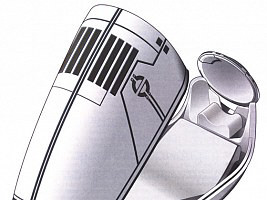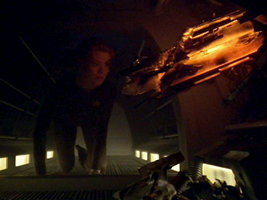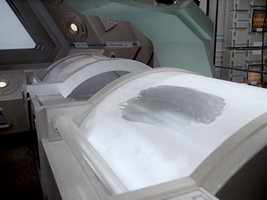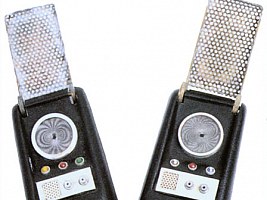Treknology Encyclopedia - C
Captain's yacht Large shuttle docked at the ventral side of the saucer hulls of Galaxy-class and Sovereign-class starships, usually deployed for diplomatic missions ("Star Trek: Insurrection", TNGTM).
The captain's yacht was never shown in 178 TNG episodes, however, it is depicted in the STTNG Technical Manual. According to Patrick Stewart, the captain's yacht of the Enterprise-D is named "Calypso".
Cardiac implant Also known as artificial heart, medical device replacing the human heart (TNG: "Samaritan Snare", "Tapestry", DS9: "Profit and Lace").Jean-Luc Picard is the most prominent bearer of a cardiac implant. Ishka, Rom's and Quark's mother, receives an artificial heart in 2374.
Cardiostimulator Medical device to support the heart activity of a patient (TOS: "Journey to Babel", VOY: "Cathexis").
Cargo bay Section of a starship which is used for storage of various cargo. Cargo bays can be accessed through docking ports or by means of cargo transporters (generic).
Cargo transporter Low-resolution high-volume transporter system for non-biological objects (TNG: "The Mind's Eye", "Power Play").
Cascade failure In particular, escalating failure in the positronic brain of a Soong-type android (TNG: "The Offspring", "Inheritance"). More generally, a failure propagating through any kind of technical system (TNG: "The Quality of Life", VOY: "The Haunting of Deck Twelve").
Although usually not explicitly called a cascade failure, we can observe on several occasions how large distributed systems are destroyed by just attacking one of its nodes (DS9: "Homefront", VOY: "Hunters", VOY: "Endgame", ENT: "Zero Hour").
Cascade virus Computer virus designed to spread through all connected memory cores, thereby disabling the whole system (DS9: "For the Uniform").
Catwalk Informal name for a passageway inside the nacelle of an NX-class starship (ENT: "The Catwalk", "The Crossing").Causality loop Sequence of events in which cause and effect cannot be distinguished. A causality loop is possible if a time travel is involved (VOY: "Relativity").
This phenomenon is extensively discussed on my time travel pages and is often referred to as causality paradox or as predestination paradox. The Star Trek Encyclopedia seems to have a different opinion on what a causality loop actually is. In the book the term is used for isolated loops in which a certain sequence of events is always repeating, like in TNG: "Cause and Effect" (and more recently in ENT: "Future Tense").
Cellular disruption Method used by the automated defense system of the Kalandan outpost, described as blasting body cells from within (TOS: "That Which Survives").
Cellular metamorphosis Technique of shapeshifting taught to Capt. Garth by the people of Antos IV (TOS: "Whom Gods Destroy").
Rather than mere "learning" how to assume another form, a technical device is very likely involved.
Cellular regeneration and entertainment chamber Medical device developed by Dr. Elias Giger that is intended to extend the human lifespan by stimulating the cells. The chamber functions by transmitting biogenic energy on a chromoelectric wavelength (DS9: "In the Cards").Even if we forgive Giger his remarkably meaningless Technobabble, his invention remains frivolous.
Cenotaph Coffin-like container used by the Vhnori for the transition to the next emanation (VOY: "Emanations").
Strictly speaking, the cenotaph is neither a "technology" from a scientific viewpoint, nor in the Vhnori religion where it is of ceremonial nature.
Central plexus Part of a Borg ship whose purpose is to control and link together the drones (VOY: "Unimatrix Zero").
The difference between the central plexus and the vinculum (VOY: "Infinite Regress") never becomes clear.
 Cetacean ops Department aboard some Starfleet ships, in which whales or dolphins perform navigation tasks (LOW: "Second Contact", "First First Contact", PRO: "Observer's Paradox" et al.).
Cetacean ops Department aboard some Starfleet ships, in which whales or dolphins perform navigation tasks (LOW: "Second Contact", "First First Contact", PRO: "Observer's Paradox" et al.).
Cetaceans are said to have a special sense for navigation, although flying with water tanks through space isn't such a great idea (well, the Xindi-Aquatics are doing it too). TNG had hints at the existence of cetacean ops in the form of a barely legible door label "Tursiops Crew Facility" in "We'll Always Have Paris". Secondary references such as the Enterprise-D Blueprints included cetacean ops.
Chambers coil Part of a starship's communication system, whose failure can overload the whole system ("Star Trek: The Wrath of Khan").
 choH'a' Species reassignment protocol developed by the Klingons in the mid-23rd century. The choH'a' is used to transform a Klingon into a human being, giving the Klingon the appearance as well as the memories of a specific human being. The true Klingon nature would be hidden deep beneath this new identity. Starfleet medical scans would not reveal the true (Klingon) nature of the patient (DIS: "Vaulting Ambition").
choH'a' Species reassignment protocol developed by the Klingons in the mid-23rd century. The choH'a' is used to transform a Klingon into a human being, giving the Klingon the appearance as well as the memories of a specific human being. The true Klingon nature would be hidden deep beneath this new identity. Starfleet medical scans would not reveal the true (Klingon) nature of the patient (DIS: "Vaulting Ambition").
Voq was transformed to Ash Tyler using choH'a'. It is not evident if and how this new identity would have given L'Rell and the Klingons any advantage over the Federation. In the end, as L'Rell is a prisoner on the Discovery and Voq-Tyler is struggling with his nature, L'Rell agrees to remove the Voq part of the identity. It is explicitly mentioned that Voq-Tyler is indeed Voq's body to look like Tyler's. But if a Klingon body is transformed, on a cellular level including a full exchange of the DNA, to be indistinguishable from a human's, doesn't this mean that there is nothing Klingon left? Rather than creating an exact replica of Tyler including his brain patterns, wouldn't it be a lot easier to just hide something in Tyler's brain patterns, as it is commonplace in Star Trek, to accomplish whatever L'Rell and Voq wanted?
Chromodynamic power module Power system of the Pralor and Cravic Automated Personnel Units. These modules are designed in a way that they cannot be replicated, thereby preventing unwanted reproduction of the androids (VOY: "Prototype").
Chroniton torpedo Krenim weapon that employs a temporal invariance of typically 1.47µs to penetrate shields (VOY: "Before and After", "Year of Hell").
Chroniton torpedoes are featured in VOY: "Before and After" and "Year of Hell". This weapon is obviously related to temporal incursion. It is not evident how the small temporal shift allows to pass through Voyager's shields as if the latter had not been there 1.47µs before. Maybe they are out of phase. Chroniton torpedoes only exist in the timeline when the Krenim Imperium is powerful, and it is not clear whether this is the case at the end of the episode "Year of Hell II".
Chronometric data Readings of the space-time continuum and of possible disruptions therein due to time travel (VOY: "Future's End").
 Chronophage See time bug.
Chronophage See time bug.
Class M Classification for a planet with a nitrogen-oxygen atmosphere. Class-M planets provide comfortable living conditions for a longer time, and the are suited for permanent accommodation of humanoids (generic).
A comprehensive definition of planet classes can only be found in non-canon sources, e.g. in the book Star Trek Star Charts or the UFP Info Terminal. At least K and L planet classes that also provide breathable air, but seem to designate desert planets, are mentioned in a couple of episodes. Star Trek inherently focuses on Earth-like planets for dramaturgical reasons, since no spacesuits are necessary and suitable sets are easy to find. Still, inhabitable planets seem to ubiquitous, and every time a shuttle is about to crash, there is "occasionally" a Class-M or at least Class-K or L planet in the vicinity. ENT: "Strange New World" establishes that the term "Class M" is obviously derived from Vulcan "Minshara-Class". See more about canon planet classes: Planet Classification.
Cloaking device Technology of Romulan origin designed to render a starship invisible to the eye and to sensors, also used by the Klingons and on the USS Defiant. The cloaking device generates a space distortion which redirects light and sensor rays around the ship, so nothing is reflected from its surface. Cloaking the ship consumes large amounts of power, therefore the simultaneous activation of the warp drive may not have been possible with the early cloaking devices in the 23rd century. Furthermore, the use of weapons is usually not possible while the cloaking device is activated (generic).
The space distortion necessary to bend light rays is equivalent to an enormous mass concentration and would certainly crush the ship and crew, so additional measures must be taken to compensate the effect inside the distortion.
Cloaking field In particular, immensely powerful cloaking used by the Aldeans to hide their whole planet (TNG: "When the Bough Breaks").
Cloning Technique to grow a new body that is genetically identical to an existing lifeform (TNG: "Up the Long Ladder", DS9: "A Man Alone"). See also genetic engineering.Cmdr. Riker and Dr. Pulaski were cloned without their consent in TNG: "Up the Long Ladder". Still, shooting at their clones with phasers was ethically wrong. The Vorta are a complete race of cloned individuals, and a Vorta like Weyoun can simply be recreated by the Founders if their predecessor is dead or regarded as unreliable.
Coaxial warp drive FTL propulsion technology which is described as bending space, not subspace, as opposed to conventional warp drive.
The description of the coaxial warp drive of "folding the fabric of space" (VOY: "Vis-à-Vis") sounds much like what several people, including author Lawrence Krauss (The Physics of Star Trek), claim how normal warp drive could work. There is no clue what the term "coaxial" may stand for.
Cochrane Measure for the subspace field stress. The unit cochrane is employed to measure the degree of a subspace field distortion and hence the power of a warp drive. The unit was named in honor of Zefram Cochrane who built the first Terran vessel to achieve warp speed (TNG: "Remember Me", "The Outcast").
The TNGTM sheds more light on the cochrane unit. The cochrane value equals the speed ratio v/c for the given warp factor. Warp 1 and therefore v=c is achieved for a subspace distortion of 1 cochrane. Values smaller than 1 cochrane correspond to sublight speed. At Warp 10, finally, the cochrane value becomes infinite because of Eugene's limit, and so does the apparent velocity. Cochranes are also used to evaluate an impulse drive or an FTL computer core.
 Cold fusion Power generation technology that purportedly exists in the 2020's (SNW: "Tomorrow and Tomorrow and Tomorrow").
Cold fusion Power generation technology that purportedly exists in the 2020's (SNW: "Tomorrow and Tomorrow and Tomorrow").
Cold fusion, just as early interplanetary travel and genetically engineered humans, exists in the Star Trek universe because of a decision not to keep in sync with our real world any longer.
Collar of Obedience Collar worn by each of the gladiators on Triskelion, with a color code indicating their particular Provider. The Providers exert control over their thralls by being able to tighten the collars (TNG: "The Gamesters of Triskelion").
Communicator Personnel subspace communication device, originally hand-held, later in the 24th century integrated in the Starfleet badge; the latter is also referred to as comm badge. The communicator serves to establish a voice contact to another person or computer and provides lock-on contact for the transporter. The comm badge is usually programmed with a crew member's individual bioelectric data, which is verified through a dermal sensor. The communicator will fail when used by an unauthorized person (generic).
Recent cellular phones are smaller than the original communicator, which is a clear indication for the progress in electronics since the 1960s and could possibly render TOS ridiculous. Still, it has to be taken into account that subspace communication is far beyond our time.
Compression phaser rifle See phaser.
Computer system Data processing, transfer and storage system utilized for a wide variety of control purposes, for scientific analysis and as a library computer. All components of the computer system are connected with each other and with the main computer core by the ODN. A number of subprocessors is distributed throughout the ship to supply additional computing capacity, improve speed and provide redundancy. On the most recent Starfleet ships the latter may be bioneural circuits (generic).
In 24th Federation starships the computer cores are equipped with subspace field generators which enable FTL data processing and transmission (TNGTM). As the data volumes as well as the clock frequencies of computers rise, light speed becomes the main limiting speed factor. Moreover, distances of several hundred meters have to be covered within starships. Hence, FTL data processing is inevitable in 24th century computers.
Condition blue See blue alert.
Condition red See red alert.
Condition yellow See yellow alert.
Construction module Remote-controlled devices for construction in space (TNG: "Final Mission").
Containment field Generic term for a forcefield used to isolate antimatter in their storage pods or hazardous biological or chemical specimens in a science lab (generic).
Containment module Special container for hazardous cargo or medical specimens. Isolated using a containment field (generic).
 Control Artificial intelligence constructed by Section 31 in the 2257s. Control was responsible for all Section 31 operations and was on the verge of becoming sentient, a goal that the AI pursued relentlessly. After Control was defeated, Starfleet denied its existence (DIS: "Such Sweet Sorrow II").
Control Artificial intelligence constructed by Section 31 in the 2257s. Control was responsible for all Section 31 operations and was on the verge of becoming sentient, a goal that the AI pursued relentlessly. After Control was defeated, Starfleet denied its existence (DIS: "Such Sweet Sorrow II").
Yet, only some ten years later, Starfleet would make another attempt to hand over the control of a starship to an artificial intelligence (TOS: "The Ultimate Computer"). See also M-5.
Controller In particular, the computer controlling the subterranean civilization of the Eymorg on Sigma Draconis VI. The Controller is in need of a humanoid brain, which has to be replaced periodically to remain operative (TOS: "Spock's Brain").
Cortical implant Piece of technology designed to provide a direct interface with a humanoid brain. Used by the Breen and most prominently by the Borg. The latter is also called cortical node (DS9: "'Til Death Do Us Part", VOY: "Night", "The Voyager Conspiracy", "Imperfection").
Cortical stimulator Medical device that stimulates brain activity through electrical shocks in case of severe injuries (TNG: "The Inner Light", VOY: "Cathexis", "Flashback", Coda", ENT: "Observer Effect").
Unlike a neural stimulator, which probably keeps up a certain level of brain activity, the cortical stimulator may be used to reactivate a defunct brain in the first place.
Counterinsurgency program Computer program on Terok Nor devised to put down a possible rebellion of the Bajoran ore workers, up to the self-destruction of the station (DS9: "Civil Defense").
In the DS9 episode the program was accidentally activated on Deep Space 9. A surprising additional subroutine took away the authority from Gul Dukat because of his alleged failure to cope with the rebellious Bajorans.
Cranial implant Biotechnological device developed by the Cardassian Obsidian Order for their operatives. The implant is devised to release endorphins, thereby making the operative more resistant to pain (DS9: "The Wire").
In "The Wire" Garak suffers from a malfunctioning implant, which was never designed for long-term operation.
Cryostasis State of low biological activity in a human body, achieved by preserving the body in a cooling chamber (generic).
Cryostasis was featured in a number of episodes, usually as a technology for long-range space travel (TOS: "Space Seed", TNG: "The Emissary", VOY: "11:59", "Star Trek Into Darkness") or to preserve a genetic pool (VOY: "The 37's"). A related technology is cryonics, meaning that the bodies of patients with incurable diseases are frozen after their deaths (TNG: "The Neutral Zone"), hoping they might be revived in the future.
Cybernetics Study of artificial lifeforms and robotics (generic).
Cytoplasmic stimulator Medical device that stimulates the production of cytoplasm in body cells. This device can be replicated (VOY: "Phage").

Back to Treknology Encyclopedia index






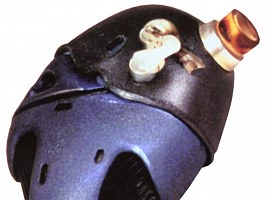
 Captain Picard's heart
Captain Picard's heart
